
The Fichtel Mountains, form a small horseshoe-shaped mountain range in northeastern Bavaria, Germany. They extend from the valley of the Red Main River to the Czech border, a few foothills spilling over into the Czech Republic. They continue in a northeasterly direction as the Elster Mountains, and in a southeasterly direction as the Upper Palatine Forest. The Fichtel Mountains contain an important nature park, the Fichtel Mountain Nature Park, with an area of 1,020 square kilometres (390 sq mi).

Annaberg-Buchholz is a town in the Free State of Saxony, Germany. Lying in the Ore Mountains, it is the capital of the district of Erzgebirgskreis.
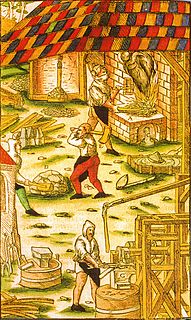
A hammer mill, hammer forge or hammer works was a workshop in the pre-industrial era that was typically used to manufacture semi-finished, wrought iron products or, sometimes, finished agricultural or mining tools, or military weapons. The feature that gave its name to these workshops was the water-driven trip hammer, or set of hammers, used in the process. The shaft, or 'helve', of the hammer was pivoted in the middle and the hammer head was lifted by the action of cams set on a rotating camshaft that periodically depressed the end of the shaft. As it rose and fell, the head of the hammer described an arc. The face of the hammer was made of iron for durability.

The 140-kilometre-long road, the Silver Road is the first and longest holiday route in the German Free State of Saxony. Against the background of the importance of mining in the history of Saxony, the road links those sights and tourist attractions of the Ore Mountains and its foreland that relate to the centuries-old mining and smelting industries of the region.

Heinrich Suter was a historian of science specializing in Islamic mathematics and astronomy.

The Ore Mountain passes are crossings and passages over the crest of the Ore Mountains in Central Europe, over which tracks, roads, railway lines and pipelines run from the Free State of Saxony in the Federal Republic of Germany to Bohemia in the Czech Republic and vice versa.

The Eastern Ore Mountains form a natural region of Saxony that covers the eastern part of the Saxon Ore Mountains range. Together with the Western and Central Ore Mountains, it is part of the larger Saxon Highlands and Uplands region. Its southern continuation beyond the German border covers an area of roughly the same extent in the Czech Republic.

The Frohnauer Hammer is an historic hammer mill in Frohnau, a village in the municipality of Annaberg-Buchholz in the Ore Mountains of southeast Germany. The mill is an important witness to proto-industrial development in the Ore Mountains. Of the once-numerous hammer mills only three others remain working in Saxony: the Dorfchemnitz Iron Hammer Mill, the Grünthal Copper Hammer Mill and the Freibergsdorf Hammer Mill.
Frohnau is a village in the Saxon town of Annaberg-Buchholz in the district of Erzgebirgskreis in southeast Germany. The discovery of silver on the Schreckenberg led in 1496 to the foundation of the neighbouring mining town of Annaberg. The village of Frohnau is best known for its museum of technology, the Frohnauer Hammer, and the visitor mine of Markus Röhling Stolln. The mining area around Frohnau has been selected as a candidate for a UNESCO World Heritage Site: the Ore Mountain Mining Region.

The Südkurier is a regional daily newspaper in Germany serving the regions northwest of Lake Constance, Hochrhein and Black Forest with its headquarters Konstanz, Germany. The paper appears with a circulation of around 130,000, six times per week in Berliner format. The predecessor of the Südkurier was the Konstanzer Zeitung.
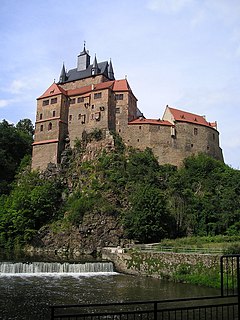
Kriebstein Castle is a castle in Kriebstein near the town of Waldheim in the German state of Saxony.
Cuisine in the Ore Mountains was dominated for centuries by the changing economic circumstances of the mining, handicraft and forestry industries, as well as the fortunes of home-based crafts. This is reflected, on the one hand, in the simplicity of cooking ingredients, the art of improvisation and creativity of the Ore Mountain housewife, and, on the other hand, in the very rich cuisine of the manor houses. For example, the lords of Schönberg, who had the closest relations with the court at Dresden, demonstrated their prosperity at the dining table. They also benefited from long-distance trade, thanks to the strategic location of their strongholds in Sayda and Purschenstein, which were situated on the so-called Salt Road. Thus they were able to enjoy the exotic spices and culinary expertise that arrived in coaches and from which their kitchens also benefited.
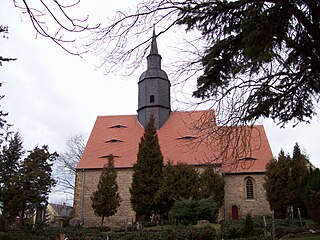
The Holy Way came about as a result of the canonization of Bishop Benno of Meissen. It led from Bohemia to Meissen and ran between Grillenburg and Wilsdruff in the present-day district of Sächsische Schweiz-Osterzgebirge in the opposite direction and parallel with the Saxon St. James' Way. Original sections of the route have survived, for example in the Tharandt Forest between Grillenburg and Spechtshausen.
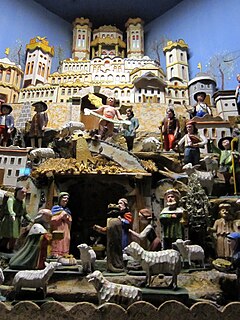
A Weihnachtsberg is a decorative, mountain-like model of the landscape of the Ore Mountains, which is set up indoors during the Christmas period. It portrays the nativity scene and mining motifs as well as local themes. The figures and objects are often movable and mechanically driven.
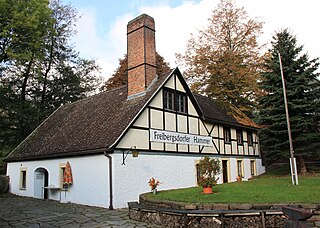
The Freibergsdorf Hammer Mill is an old hammer works that was used for metalworking in the village of Freibergsdorf in the German Ore Mountains. The site represents an important witness to proto-industrial development in the Ore Mountains. Of the once-numerous hammer mills, only three others remain working in Saxony: the Frohnauer Hammer, the Dorfchemnitz Iron Hammer Mill, and the Grünthal Copper Hammer Mill.

Hauberg is a type of communal forest management that is typical of the Siegerland and adjacent parts of the Lahn-Dill Uplands and the Westerwald in central Germany. Its aim is to manage the forest in order to produce tanbark and charcoal for the regionally important iron ore industry as well as firewood. In addition to forestry uses, the area also has agricultural uses, such as the growing of rye and buckwheat, typical of shifting cultivation, in the year after the timber harvest, as well as subsequent communal grazing (commons).
Robert Bleichsteiner was an Austrian ethnologist.
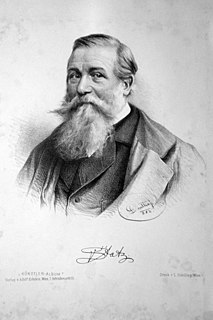
Vincenz Statz was a Neo-Gothic German architect, mainly active in the Rhineland.

The Erla Ironworks has its origins in one of the oldest hammer mills in the Upper Ore Mountains, which was first recorded in 1380 as the Hammer in der Erl, making the ironworks the oldest existing business in the German state of Saxony.
Rudolf Köselitz was a German painter and Illustrator.



















